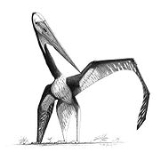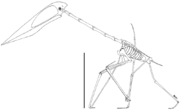
Zhejiangopterus
Encyclopedia
Zhejiangopterus is a genus
of azhdarchid
pterosaur
known from one species, which lived in China during the late Cretaceous Period.
 The genus was named in 1994 by Chinese paleontologists Cai Zhengquan and Wei Feng. The type species
The genus was named in 1994 by Chinese paleontologists Cai Zhengquan and Wei Feng. The type species
is Zhejiangopterus linhaiensis. The genus name refers to Zhejiang
Province and a Latinised Greek pteron, "wing". The specific name refers to the city of Linhai
.
In 1986 a young chalkstone quarry worker named Xu Chengfa, found a large fossil near the village of Aolicun. Xu by letter informed the director of the Zhejiang Museum of Natural History at Hangzhou
, Ming Hua, who from it understood the remains were those of an unknown pterosaur. Therefore he sent a team consisting of the describers and Wu Weitang to investigate. They secured the fossil, instructing the local population to be alert for possible further finds. Xu himself managed to find three more specimens before being killed in an accident in 1988; another worker found a complete skull.
In the early nineties in total six larger fossils had been recovered from the Tangshang Formation
, a 81.5 million year old layer from the Campanian
. Among those was the holotype
, ZMNH M1330, the impression of the skull of a juvenile individual. Several paratype
s were referred: ZMNH M1325, a skeleton lacking the skull; ZMNH M1328, an almost complete skeleton and ZMNH M1329, a fragmentary skeleton.
Zhejiangopterus was a moderately large pterosaur. Its wingspan
was first estimated at five metres (16.4 feet). Later estimates reduced this to about 3.5 metres. Its skull was long, low, perfectly arched, and lacked a "keel" or any other crest sometimes seen in related species. The nasal opening and the large opening typically present between the nose and eye openings of archosaur
s (the "antorbital fenestra") had joined together in species such as this to create a single oval opening that occupied nearly one half the length of the skull. The beak was long, thin, sharply pointed, and lacked teeth. The cervical vertebrae were elongated. The first six dorsal vertebrae had fused into a notarium
. Several pairs of belly ribs were preserved. Its upper leg bone was half the size of its upper arm bone, and strong and thin. The wings were short but robust
Zhejiangopterus was by the original describers classified as a member of the Nyctosauridae
, because of the two edentulous pterosaurs they possessed good descriptions of, Pteranodon
and Nyctosaurus
, it showed the most resemblance to the latter. They deplored lacking good data on Quetzalcoatlus
. Indeed in 1997 David Unwin determined that Zhejiangopterus was more closely related to this giant American form and thus belonged to the Azhdarchidae
. No other azhdarchid is known from such complete skeletal material.
Genus
In biology, a genus is a low-level taxonomic rank used in the biological classification of living and fossil organisms, which is an example of definition by genus and differentia...
of azhdarchid
Azhdarchidae
Azhdarchidae is a family of pterosaurs known primarily from the late Cretaceous Period, though an isolated vertebrae apparently from an azhdarchid is known from the early Cretaceous as well...
pterosaur
Pterosaur
Pterosaurs were flying reptiles of the clade or order Pterosauria. They existed from the late Triassic to the end of the Cretaceous Period . Pterosaurs are the earliest vertebrates known to have evolved powered flight...
known from one species, which lived in China during the late Cretaceous Period.

Type species
In biological nomenclature, a type species is both a concept and a practical system which is used in the classification and nomenclature of animals and plants. The value of a "type species" lies in the fact that it makes clear what is meant by a particular genus name. A type species is the species...
is Zhejiangopterus linhaiensis. The genus name refers to Zhejiang
Zhejiang
Zhejiang is an eastern coastal province of the People's Republic of China. The word Zhejiang was the old name of the Qiantang River, which passes through Hangzhou, the provincial capital...
Province and a Latinised Greek pteron, "wing". The specific name refers to the city of Linhai
Linhai
Linhai is a city in Taizhou prefecture, Zhejiang Province situated on the banks of the Lin River in Eastern China. Its wall attracts many tourists...
.
In 1986 a young chalkstone quarry worker named Xu Chengfa, found a large fossil near the village of Aolicun. Xu by letter informed the director of the Zhejiang Museum of Natural History at Hangzhou
Hangzhou
Hangzhou , formerly transliterated as Hangchow, is the capital and largest city of Zhejiang Province in Eastern China. Governed as a sub-provincial city, and as of 2010, its entire administrative division or prefecture had a registered population of 8.7 million people...
, Ming Hua, who from it understood the remains were those of an unknown pterosaur. Therefore he sent a team consisting of the describers and Wu Weitang to investigate. They secured the fossil, instructing the local population to be alert for possible further finds. Xu himself managed to find three more specimens before being killed in an accident in 1988; another worker found a complete skull.
In the early nineties in total six larger fossils had been recovered from the Tangshang Formation
Tangshang Formation
The Tangshang Formation is a Mesozoic geologic formation. Dinosaur remains diagnostic to the genus level are among the fossils that have been recovered from the formation.-See also:* List of dinosaur-bearing rock formations...
, a 81.5 million year old layer from the Campanian
Campanian
The Campanian is, in the ICS' geologic timescale, the fifth of six ages of the Late Cretaceous epoch . The Campanian spans the time from 83.5 ± 0.7 Ma to 70.6 ± 0.6 Ma ...
. Among those was the holotype
Holotype
A holotype is a single physical example of an organism, known to have been used when the species was formally described. It is either the single such physical example or one of several such, but explicitly designated as the holotype...
, ZMNH M1330, the impression of the skull of a juvenile individual. Several paratype
Paratype
Paratype is a technical term used in the scientific naming of species and other taxa of organisms. The exact meaning of the term paratype when it is used in zoology is not the same as the meaning when it is used in botany...
s were referred: ZMNH M1325, a skeleton lacking the skull; ZMNH M1328, an almost complete skeleton and ZMNH M1329, a fragmentary skeleton.
Zhejiangopterus was a moderately large pterosaur. Its wingspan
Wingspan
The wingspan of an airplane or a bird, is the distance from one wingtip to the other wingtip. For example, the Boeing 777 has a wingspan of about ; and a Wandering Albatross caught in 1965 had a wingspan of , the official record for a living bird.The term wingspan, more technically extent, is...
was first estimated at five metres (16.4 feet). Later estimates reduced this to about 3.5 metres. Its skull was long, low, perfectly arched, and lacked a "keel" or any other crest sometimes seen in related species. The nasal opening and the large opening typically present between the nose and eye openings of archosaur
Archosaur
Archosaurs are a group of diapsid amniotes whose living representatives consist of modern birds and crocodilians. This group also includes all extinct non-avian dinosaurs, many extinct crocodilian relatives, and pterosaurs. Archosauria, the archosaur clade, is a crown group that includes the most...
s (the "antorbital fenestra") had joined together in species such as this to create a single oval opening that occupied nearly one half the length of the skull. The beak was long, thin, sharply pointed, and lacked teeth. The cervical vertebrae were elongated. The first six dorsal vertebrae had fused into a notarium
Notarium
Notarium is a term used for the fused vertebra of the shoulder in birds and some pterosaurs. The structure helps brace the chest against the forces generated by the wings. In birds, the vertebrae are only in contact with adjacent vertebrae and ribs, while in some pterosaurs the notarium...
. Several pairs of belly ribs were preserved. Its upper leg bone was half the size of its upper arm bone, and strong and thin. The wings were short but robust
Zhejiangopterus was by the original describers classified as a member of the Nyctosauridae
Nyctosauridae
Nyctosauridae is a family of specialized soaring pterosaurs of the Cretaceous Period of North America and, possibly, Europe. It was named in 1889 by Henry Alleyne Nicholson and Richard Lydekker....
, because of the two edentulous pterosaurs they possessed good descriptions of, Pteranodon
Pteranodon
Pteranodon , from the Late Cretaceous geological period of North America in present day Kansas, Alabama, Nebraska, Wyoming, and South Dakota, was one of the largest pterosaur genera and had a maximum wingspan of over...
and Nyctosaurus
Nyctosaurus
Nyctosaurus is a genus of pterodactyloid pterosaur, the remains of which have been found in the Niobrara Formation of the mid-western United States, which, during the late Cretaceous Period, was covered in an extensive shallow sea. The genus Nyctosaurus has had numerous species referred to it,...
, it showed the most resemblance to the latter. They deplored lacking good data on Quetzalcoatlus
Quetzalcoatlus
Quetzalcoatlus was a pterodactyloid pterosaur known from the Late Cretaceous of North America , and one of the largest known flying animals of all time. It was a member of the Azhdarchidae, a family of advanced toothless pterosaurs with unusually long, stiffened necks...
. Indeed in 1997 David Unwin determined that Zhejiangopterus was more closely related to this giant American form and thus belonged to the Azhdarchidae
Azhdarchidae
Azhdarchidae is a family of pterosaurs known primarily from the late Cretaceous Period, though an isolated vertebrae apparently from an azhdarchid is known from the early Cretaceous as well...
. No other azhdarchid is known from such complete skeletal material.
External links
- Zhejiangopterus in The Pterosauria

